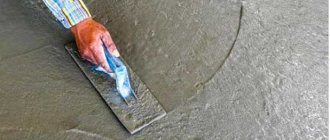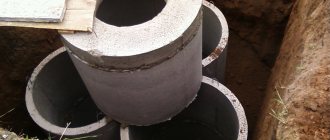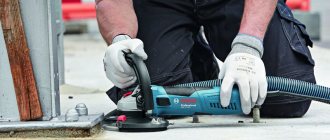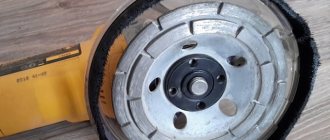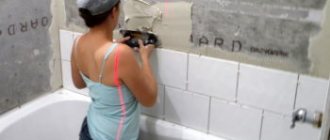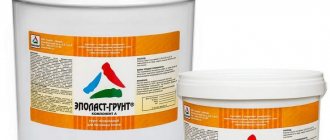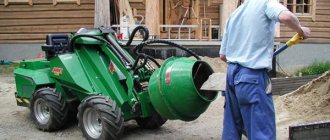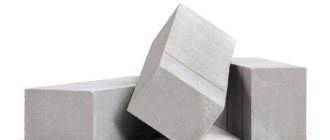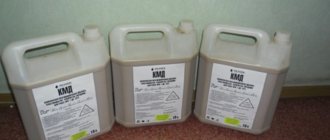What is a grinding machine
Hand-processing stone surfaces is quite difficult and time-consuming. To make work easier and save time, use special power tools.
A concrete grinder is suitable for processing such surfaces.
Power tools are rotating discs to which an abrasive element is attached. Different grain sizes of the tool, as well as adjustable power, allow you to achieve different types of processed surfaces: matte, glossy, mirror-glossy.
Floor sander Victor Trojan 17
Purpose: Preparing a stone surface, removing old films and varnishes Grinding and polishing marble and granite with a diamond tool using an additional weight Crystallization of marble Washing stone and care Applying wax mastics Final polishing of granite using a two-component system Technical characteristics: motor - 220 V, 1.5 kW speed - 180-200 rpm disk - 450 mm weight - 38 kg metal body The body is made of anti-corrosion material and can withstand the effects of any professional chemicals. An exceptionally powerful machine. For effective polishing of marble and granite, it can be loaded with an additional weight of up to 30 kg. Supplied complete with a 450 mm pad holder Country of origin: England Price RUB 125,225*Design Features
Many large companies offer a huge number of models of grinding machines.
They are all different from each other, but from a design point of view they all consist of similar elements, such as: support frame, control levers, motor, abrasive part.
When choosing a grinder, it is important to take into account such characteristics as:
- dimensions of the abrasive element;
- power of the power tool;
- model weight.
A properly selected tool will remove the old layer from the surface and give the new coating a perfect smoothness.
Advantages and disadvantages
The main advantage is that today stores offer a wide range of machines for grinding concrete. They are quite easy to use and do not require any special skills to operate.
One of the significant advantages of the units is a wide range of attachments that increase the functionality of the grinding machine.
In addition to all of the above, the equipment can operate without breakdowns for a long time.
The main disadvantage is the large amount of dust that is generated during operation of a concrete floor grinder. Another disadvantage is the fact that you will have to spend a considerable amount of money on additional materials.
Types of grinders
One of the characteristics of the classification of mosaic grinding units is the type of power plant:
The presence of an electric motor in the device makes it tied to the room.
The gasoline engine makes the equipment more productive, but requires effective ventilation of the room.
- Electric motor. The main models of household devices that can be used indoors are equipped with such a motor. They are environmentally friendly and silent. The disadvantage is the need to connect to the electrical network.
- Gasoline power plant. The machine is completely autonomous, has high productivity and power output. The downside is that it is difficult to operate in enclosed spaces due to toxic carbon monoxide. In this case, it is necessary to equip a powerful exhaust system.
The tool is classified according to the presence of a function for adjusting the speed of the abrasive segments:
Single-speed devices are convenient for polishing monolithic floors.
- Cars with one speed. In such models, the nozzles can rotate up to 1200 rpm. This ability allows polishing of monolithic structures.
- Two-speed units. Used for roughing and finishing operations, the segments rotate at 500-800 rpm.
According to the method of movement of the car there are:
- Manual. During work, the tool is moved along the structure being processed by the worker. The device is used in facilities with small volumes of processed areas. The nozzles in them are made of simple abrasive material or diamond. There are models with a water tank, which is used to moisten the concrete surface.
- Self-propelled. Used for work on an industrial scale. They are equipped with various types of power plants. The unit is controlled remotely using a control panel. Depending on the model, the machines are equipped with 2 or 3 working attachments.
An industrial unit can be self-propelled.
The water supply pipes in self-propelled mosaic grinding units are changed after 6 months of intensive work.
Types of tools by type of purpose
The sander is truly an incomparable assistant for every builder. It is necessary when it is necessary to achieve ideal smoothness of concrete. This measure is especially used before finishing.
Power tools can be divided into four categories based on their purpose, described below.
Household power tools
This group of power tools is suitable for small-scale jobs. They are purchased for repairs in a house or at a summer cottage.
Typically, such grinders are not designed for long-term work, so they have little power. They cannot bear serious loads. To avoid equipment failure, it is recommended to follow the instructions.
Professional equipment
Professional tools are designed to perform heavy-duty work without interruption.
They are also capable of processing large surface areas.
This equipment has great power and is intended for construction work.
Mostly large companies purchase professional equipment.
Screed alignment
A screed sander is necessary to level surfaces. In addition, it is used for rubbing seams. Just like professional equipment, a screed grinder has a lot of power. The use of the tool is narrowly targeted. It is only suitable for leveling the screed.
Stone grinding
To level roads and sidewalks, purchase a special tool. It is recommended for treating stone or asphalt surfaces. To polish the stone, the machine is equipped with additional metal shields.
Types of tools by type of design
Depending on the method of work performed and the types of materials processed, grinding machines on sale are available in different sizes and differ in structure.
Angle grinders
Angle grinders are purchased for simple work.
They are small in size, used in hard-to-reach places and are capable of cutting hard materials. People call them grinders for grinding concrete. Angle models are considered hand-held concrete grinders.
Belt type models
Belt machines are needed for rough processing of concrete.
During the initial polishing of surfaces, it removes large irregularities. An abrasive belt is required for sanding. Its value affects the processing speed.
Vibration technology
If pre-finishing is required, an oscillating sander will be required.
For work, special sheets are used that are attached to the sole.
The grain size of these sheets varies.
The elements used for grinding require replacement after some time.
This is the only minor drawback that affects the speed of operation.
Eccentric models
To perform rough processing, eccentric machines are purchased.
They are able to qualitatively prepare the surface even for finishing. They are difficult to use in hard-to-reach places. Eccentric technique is considered professional.
Mosaic grinding power tools
The concrete mosaic grinder is capable of processing stone or concrete walls. The device is suitable for polishing and roughening surfaces.
Concrete grinder - types of tools
The grinding technique is different:
- functional purpose;
- design.
Let us consider this classification in detail.
Concrete grinding machine - classification by application
Depending on the area of application and the specifics of the tasks being solved, grinding devices are divided into the following types:
- household concrete grinder. It is used to carry out construction activities at home with a reduced processing area. It has low power and requires periodic breaks when performing work. The design does not allow overloading the device, which should be operated strictly according to the instructions. Advantages: affordable price and light weight;
Processing stone surfaces manually is a labor-intensive and time-consuming process that does not always give the desired result.
- professional concrete grinder. Equipped with a high-power drive motor, which increases productivity. The power reserve and design features allow long-term operation of the device under increased load. This type of equipment is used by specialized construction organizations when performing increased volumes of work;
- machine for polishing floors (leveling screeds). It is intended for leveling the foundation and eliminating defects. The increased power of the electric motor allows the required number of passes to be completed in a limited time to ensure the quality of the concrete floor. Such equipment is not intended for other work;
- device for polishing stone. It is a tool with a narrow functional purpose. The original design of the working body, equipped with special nozzles, allows you to quickly achieve the minimum roughness of natural stone. The design of the equipment allows planning not only the concrete surface, but also the asphalt surface of sidewalks and highways.
Select grinding equipment to perform specific tasks based on the intended purpose.
Concrete grinder - design options
The design of the grinding machine differs depending on the design solutions laid down by the manufacturer, as well as the specifics of the application.
Concrete grinding equipment is an indispensable tool for the builder
The following units are produced:
- angle grinder for concrete grinding. The main task of this tool is to perform work on cutting concrete, natural and artificial stone, as well as grinding operations. This type of tool is called a “grinder”, the peculiarity of which is its small dimensions and light weight. It is convenient to use with limited access and in corner areas. Some modifications have a mechanism that reduces vibration during uneven wear of the grinding wheel;
- belt sander for floors. It is used for manual finishing of the surface. The main area of use is roughing to eliminate rough concrete flows and remove significant differences in height. During operation of the tool, an sanding belt located on cylindrical drums comes into contact with the concrete surface. The design features of the grinding device allow you to change the speed of movement of the abrasive belt;
- vibrating grinding machine for concrete. Models in this category are used for preliminary finishing of the concrete base before the final stage of processing. The grinding process is carried out by exposing the concrete surface to a special platform on which sheets of abrasive with different levels of grain are fixed. The intensity of the impact of the working body varies depending on the amplitude of vibration oscillations;
- orbital sander for floors. It is able to provide ideal surface quality. Increased efficiency of the concrete base grinding process is ensured by combining the vibration effect with the rotational movement of the working nozzle. There are weaknesses in the design. This is limited operating time and reduced productivity with a small tool diameter;
This category of tool is suitable for performing small amounts of grinding work, for example, for home or garden renovations.
- grinding machine for concrete floor with mosaic pattern. It has proven itself as reliable equipment when processing mosaic surfaces, as well as ensuring increased cleanliness of natural stone and concrete. The design of the working body, made in the form of a rotating abrasive disk, ensures accelerated removal of concrete sagging and the required level of roughness, as well as polishing of stone and cement surfaces.
When thinking about purchasing equipment to perform specific tasks, you should carefully study design options.
How to choose
Sometimes choosing a grinder becomes quite difficult due to the huge variety of models. A thorough study of the features of each type of tool and its scope of application will help you decide. It is also important to determine what technical characteristics the machine should have.
Tool power
This indicator affects the performance of the model. The longer a tool can work without interruption, the greater its power.
This parameter should be in the range from 600 W to 3000 W. If you need to work on treating a small area of concrete surface, grinding the concrete with a grinder is the best option. These power tools typically range from 600 watts to 1000 watts. Larger-scale work can be done with equipment with power from 1500 W to 2000 W.
Disk size
The size of the disc affects the surface area being processed. Products come in three types:
- small;
- average;
- big.
The small disk is 15 cm in diameter, the medium one is 15-20 cm, and the large one is 25 cm. Size is directly related to rotation speed.
So, the higher the speed, the smaller the disk size should be. Tools with a rotation speed of 300 rpm can perform rough processing of concrete.
High-quality grinding will be ensured by equipment operating at a frequency of 48,000 rpm.
Concrete grinder - recommendations for choosing
The expanded range of professional and household appliances presented in construction supermarkets makes it difficult to make a decision on purchasing a specific model to complete the work. However, there are criteria, a careful study of which makes it easier to select the necessary grinder.
It is important to pay attention to the following points:
- installed drive power;
- dimensions of the grinding disc;
- disk rotation speed;
- spindle thread size;
- additional equipment;
- manufacturer's company.
Let us dwell in detail on the main selection criteria.
This type of tool is distinguished by high power indicators, therefore it is capable of processing large areas
Power
This characteristic defines:
- device performance;
- possibility of continuous operation.
Depending on the installed power, the area of use also changes:
- hand grinding tools with a power of 0.8–1.5 kW are used for household purposes. During an hour of work, it is necessary to take three or four breaks to cool the motor;
- professional units with a drive station power of 1.5–6 kW are designed to operate with increased load. They can work for a long time without stopping.
With increasing power, the cost of the grinder increases, the weight increases and, naturally, the energy intensity increases.
Disc diameter and rotation speed
The dimensions and rotation speed of the working body are determined by:
- surface area to be ground;
- intensity of removal of irregularities;
- duration of grinding work.
As a rule, a professional grinding machine is recommended for use by construction companies carrying out large-scale work.
The dimensions of the disc are selected to solve specific problems. For example, for manual models of sanders, discs of various diameters are used:
- up to 15 cm – for fine polishing of a small area of a concrete surface;
- 15-20 cm – for effective cleaning of seams and corner areas;
- up to 25 cm – for rough grinding of a concrete base with unevenness.
The dimensions of the working body and the rotation speed are inextricably linked with the specifics of the work:
- at minimum speed you can perform rough grinding;
- final polishing requires maximum rotation speed.
As the rpm increases, a smaller diameter disc should be used.
Spindle thread
The dimensions of the spindle part determine the possibility of using different types of disks. Most models allow you to fix the working disk using an M14 thread. At the same time, there are grinders with M16 spindle threads. The seat size of the grinding disc depends on this parameter.
Additional features
When choosing a grinder, pay special attention to the following points:
In addition to application features, design parameters are used to classify grinding machines
- handle design that dampens vibration and can be fixed or rotary;
- the presence of a speed stabilization device that allows you to maintain a constant speed;
- the presence of a sealed dust collector, which is integrated into the device body or located separately;
- a device for smoothly changing the rotation speed, which allows you to select the optimal mode;
- possibility of operation from a battery, allowing operation in the absence of mains power supply;
- locking the start button, which prevents the possibility of accidental activation.
The following factors are also important:
- vibration level;
- noise characteristics;
- possibility of supplying water to the work area.
Manufacturer
The image of the manufacturer is important when purchasing special equipment. Preference should be given to proven brands that have proven themselves in the construction equipment market.
Professional builders prefer the following brands:
- Bosch;
- Stern;
- Hitachi;
- Sparky;
- Makita.
It is advisable to buy sanders at specialized retail outlets, where they can give an official guarantee.
What do manufacturers offer?
When choosing equipment for polishing concrete, it is recommended to give preference to well-known manufacturers. Most popular brands:
- Bosch;
- Interskol;
- Makita.
Manufacturers guarantee that their models are of high quality and will last a long time. You can purchase equipment for grinding concrete at a hardware store. It is also possible to rent it.
Advice!
It is recommended to buy equipment in large construction stores. They also guarantee high-quality service for power tools.
Types of grinding
Grinding concrete is necessary to give it strength. In the future, this measure will save money that would be required to restore the foundation.
The polished surface is moisture resistant and can also withstand environmental influences.
Today, self-leveling concrete floors are becoming increasingly in demand. They are applied only to a flat surface. The grinding process will help make it this way. For this type of work you need a power tool called a grinder.
There are several types of concrete processing, including:
- dry grinding;
- wet;
- polishing
The dry method is applicable on an ordinary concrete base. This method will take longer. During the grinding process, a lot of dust is generated in the air. But visibility with this type of processing is still better than with wet processing. That is why it is easier for the master to detect shortcomings and immediately eliminate them.
Wet sanding is needed for floors covered with mineral chips or mosaic. As a result of using an abrasive grinding disc for concrete, a smooth surface is formed.
Polishing will transform the base, it will become smooth with a beautiful mirror shine.
Do-it-yourself concrete grinding
Concrete grinding is used to remove limescale. It may appear after pouring the solution. For these purposes, you can make a concrete grinder with your own hands, use a grinder or a professional tool. After treatment, the concrete will become stronger and take on a renewed appearance.
Work before grinding
An important point is the preparation of the base.
At this time, the old coating is removed. Usually after this process all kinds of cracks and potholes appear. Grinding over time will help eliminate them. If cracks appear in the base, they must be sealed.
The surface is inspected for the presence of reinforcement bars or metal mesh. If they exist, they must be eliminated. It is also important to tap the entire base area. If a weak area is detected, the filling must be done again.
Concrete grinding process
You can start grinding 2-3 weeks after the concrete has hardened.
This time is enough for the foundation to become strong enough.
First, the surface is treated with a hardener. It contributes to the appearance of a mixture that clogs the pores. After this, the screed becomes impervious to moisture.
Discs with diamond segments are used for grinding concrete. Rough processing is done with a grit of 40, and for finishing it is necessary to use from 500 to 1500. After finishing, polishing of the concrete begins.
The final stage is the installation of skirting boards. In addition, the surface is coated with polyurethane varnish, making the base glossy. To make it look like natural stone, you will need special discs for grinding concrete. Their use will give the base an almost mirror-like appearance.
Pothole Removal
A regular grinder is suitable for removing small potholes.
This will allow you to spend much less money and time. A large circle for grinding concrete on a grinder is capable of processing a huge area. If the concrete surface is severely damaged, then you must follow the instructions:
- First prepare the surface and remove all dust.
- Expand the potholes to the sides by a distance of 2-3 cm.
- At the site of the flaw, make a rectangle-shaped depression. For these purposes, you can use a hammer drill or a hammer and chisel.
- Next, clean the pothole from dust and prime it.
- Fill the pothole with mortar.
- After drying, sand.
Advice!
Wear protective clothing, goggles and a respirator. Open the windows in the room.
Purpose and types
Concrete grinding is most often used when working with flooring. This process allows you to achieve not only an aesthetically pleasing appearance, but also creates the basis for further covering of the floor.
In addition, polished concrete becomes stronger and less susceptible to moisture, which allows it not to undergo destruction for a long period.
The appearance of the tool is associated with the invention of the electric motor. But who first invented the grinding machine is still not known for certain. According to one version, its ancestor was the German concern BOSCH, founded in 1886, which today is one of the largest manufacturers of power tools in the world. According to another assumption, the developer was AEG Powertools. AEG, also headquartered in Germany, was founded in 1883 and was considered a leader in the production of grinding equipment until the outbreak of World War II.
When used for grinding and polishing substrates, electric machines differ in their operating principle. The following types are distinguished:
- tape;
- vibration;
- eccentric;
- corner;
- straight;
- brushed
There are two ways to perform concrete grinding: wet and dry. The first method is preferable, since it does not generate dust, but wet sludge appears instead. Wet processing of the base allows you to achieve maximum smoothness, almost satin. At the same time, dry work is characterized by significant generation of large amounts of dust and requires the use of additional personal protective equipment.
The general principle of operation for all concrete grinders is to ensure mechanical contact of the abrasive material with the surface of the base being processed.
For this, a drive is used that forces this material to perform various types of movements. The tool performs the following work:
- grinding and polishing of concrete surfaces;
- removal of a worn layer with impaired characteristics;
- leveling the bases;
- improving the adhesion of surfaces by creating roughness on them.
Difference in operating principle
The most common type of device in the household segment is angle grinders (angle grinders). With their help, it is easy to not only grind, but also cut stone or concrete, even in hard-to-reach places. The design of the angle grinder is based on a rotary engine. A toothed gear is installed on its shaft, which meshes with the gears of the drive spindle. A special feature of using this type of machine is its high speed.
Vibrating and belt tools differ from other types of sanders in their simple controllability and low weight. Consumables have the lowest price.
The operation of the tools is based on the principle of reciprocating movement of the grinding attachment. The abrasive material is secured using clamps, which makes changing it convenient. This type of machine is used in the final stage for polishing concrete. Fabric-based tapes are used as attachments.
Recommendations for care and use
Before replacing attachments or during repairs, be sure to disconnect the device from the power supply. After work, the grinder and accessories are cleaned.
Power tools should be stored in a place where children or animals cannot find them.
Persons who do not know how to use a grinder are advised to read the operating instructions for the power tool before starting work.
A concrete grinder is necessary for preparing hard surfaces for further finishing; its use also helps to fill in defects and form a screed.
A wide range of models from different manufacturers will allow you to buy or rent the necessary equipment for a specific type of work.
Important!
The tool should only be used for its intended purpose.
This is also important from a safety point of view. The machine is designed for a specific type of work. It is recommended to use the tool only after reading the instructions. Otherwise, you may be injured or the tool may be damaged. Do not use equipment with a faulty switch. Such equipment must be sent in for repair.
